From Death to grand jury : A timeline
Aug. 9: Police officer Darren Wilson encountered Michael Brown, 18, and a friend as they walked down a street. Wilson fatally shot Brown.
Aug. 10: St. Louis County Police Chief Joe Belmar said during a news conference that Brown was unarmed. Belmar said there was a struggle in which Brown reached for the gun of the officer, who at the time was not identified.
Aug. 11: People gathered outside the Ferguson Police Department, leading to several arrests. The FBI announced it would conduct a parallel investigation. The St. Louis County Police Department said it would release the name of the officer accused of shooting Brown by the next day. Brown's parents held a news conference demanding justice. Police used tear gas to disperse crowds on West Florissant Avenue.
Aug. 12: Police announced more arrests from the prior evening. The St. Louis County Police Department said it would not release the officer's name because of threats. President Obama released a statement: "The death of Michael Brown is heartbreaking, and Michelle and I send our deepest condolences to his family and his community at this very difficult time." Protests continued for a third night as Missouri Gov. Jay Nixon, St. Louis Mayor Francis Slay and other leaders met.
Aug. 13: The prosecutor's office revealed that Brown had no criminal record. The U.S. Justice Department opened a civil rights inquiry.
Aug. 14: After Obama addressed the nation and urged police to be "open and transparent," Nixon announced that the Missouri Highway Patrol would oversee security in Ferguson.
Aug. 15: Six-year police veteran Darren Wilson was named as the officer who shot Brown. Police Chief Thomas Jackson released surveillance video of a nearby robbery. Brown's family said they were "beyond outraged" by police efforts to tie Brown to the robbery. Jackson said Wilson stopped Brown for walking in the middle of the street.
Aug. 16: Nixon issued a state of emergency for Ferguson and imposed a curfew.



